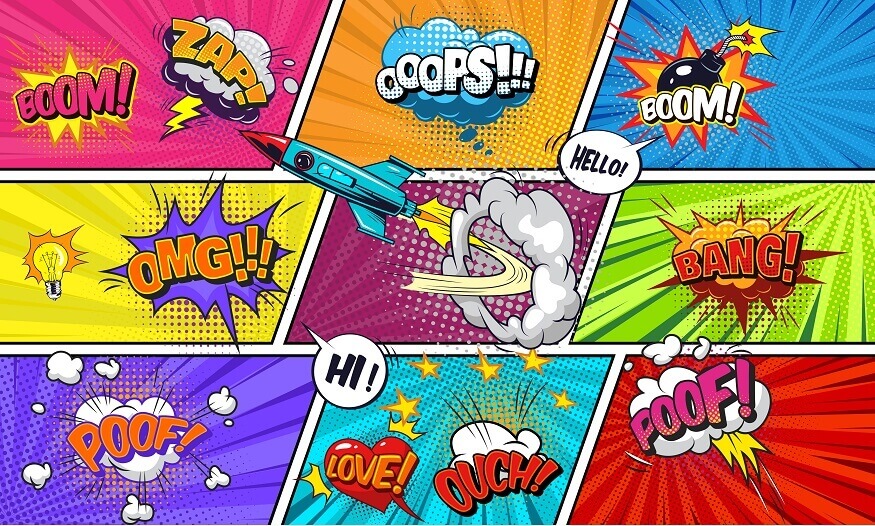Comic art has captivated audiences with its vibrant illustrations and engaging storytelling for many years. Featuring superheroes, anti-heroes, dramatic narratives, and whimsical humour, comic art has resonated with both young and mature audiences. If you are fascinated by this art form and want to embark on this creative journey, this beginner’s guide to comic art can provide a good start.
Also Read: How to Encourage Your Child to Write and Draw
Understanding Comic Art
Comic art is a mode of storytelling that uses visual and textual elements in sequence. Mostly found in newspapers’ comic strips or comic books, today comic art has extended to graphic novels and webcomics. This dynamic form of art has evolved beyond just entertainment; in the current day and age, it has become a powerful tool for social commentary, visual storytelling, and an exploration of the human experience.
Learning to appreciate comic art involves knowing what differentiates it from other art forms. Unlike a single painting or sculpture that deals with one moment, one perspective, comic art could be compared to a multidimensional narrative such as filmmaking.
It involves timing, transitions, multiple points of view, angles, character designs, and set designs. Hence, understanding comic art involves appreciating not only the individual panels as disparate art pieces but also their interaction which leads to a seamless narrative flow.
However, comic art is much more than a simple interplay of visuals and text. It requires an exploration of the cultural context and historical backdrop surrounding the art. After all, comics often reflect, criticise, and satirise contemporary societal norms and politics.
It is also important to appreciate comic art for its unique artistic language. Each artist or writer often devises a distinct visual style or narrative technique, and it is fascinating to see such personal imprints on the stories.
Understanding comic art also involves recognizing its social impact. Not just as a reflection of society, but as a catalyst for change as well. Stories dealing with themes such as civil rights, environmentalism, and gender equity have seen a rise in the comic art industry, using visual narratives to advocate social causes convincingly and effectively.
Also Read: How Art Education Can Enhance Children’s Creativity
Comic art formats
Comic art has diversified into a multitude of genres and styles, characterising humour, drama, fantasy, history, horror, science fiction and more, and continues to evolve, creating its unique visual appeal. There are different types of comic art as given below which are making comic art an essential part of popular culture.
1) Single-Panel Comics
These comics present a complete story or concept in a single frame or panel. Many famed newspaper cartoons, like ‘The Far Side’ by Gary Larson and ‘Dilbert’ by Scott Adams, follow this style. The artist carefully devises the art and dialogue to present a conclusive thought or joke effectively within a single panel.
2) Strips
Comic strips, traditionally published in newspapers, consist of a sequence of related panels. The most recognized comic strips include ‘Peanuts’ by Charles M. Schulz and ‘Calvin and Hobbes’ by Bill Watterson. They may offer episodic narrative arcs or standalone stories, generally encompassing three to four panels.
3) Comic Books
Comic books, also known as ‘floppies’, are variant forms of comic art featuring lengthy, continuous narratives that can extend over multiple issues. Examples include DC’s ‘Batman’ or Marvel’s ‘Spider-Man’. Comic books typically dwell upon plot twists, character development, and immersive story arcs.
4) Graphic Novels
As the novel-like name suggests, these are extended comic narratives that have complex storylines with sophisticated visual and textual elements. Works like ‘Maus’ by Art Spiegelman and ‘Persepolis’ by Marjane Satrapi, focus on serious themes through graphic storytelling.
5) Manga
Manga is a distinctive Japanese comic art form that is read from right to left. Manga covers a wide array of genres, catering to various demographics—from children to adults. The ‘shōnen’ and ‘shōjo’ are the main divisions, intended for young boys and girls respectively. Familiar manga titles include ‘Naruto’, ‘Bleach’, and ‘One Piece’.
6) Webcomics
The digital-native format of comics, webcomics, thrives on the internet. This platform gives artists the freedom to defy traditional comic conventions concerning size, layout, and periodicity. Some cherished Webcomics include Randall Munroe’s ‘XKCD’ and Ryan North’s ‘Dinosaur Comics’.
7) Editorial Cartoons
These cartoons, also known as political cartoons, are a blend of visual art and journalism. They weave pertinent social and political issues through satire and caricature. Famous editorial cartoonists include the likes of R.K. Laxman and David Low.
8) Gag-A-Day Comics
These comics purely focus on humour, often resorting to absurdity and slapstick comedy. They do not follow a continuing plot, with each strip or page containing a separate joke or punchline. Popular examples are ‘Garfield’ by Jim Davis and ‘Beetle Bailey’ by Mort Walker.
9) Superhero Comics
This genre, popularised by Marvel and DC, chiefly focuses on characters with superhuman abilities involved in combating evil or harm. ‘Superman’, ‘Wonder Woman’, ‘Iron Man’, and ‘The Flash’ are perfect epitomes of this type.
Also Read: How to create leaf art and drawing for children
Process of bringing your comic art to life
Creating a comic involves five fundamental steps: Conceptualising, scripting, drawing, inking, and colouring.
- Conceptualising: This initial step involves exploring your idea, setting, characters, and plot. Thumbnail sketches can help visualise the storyline. A well-crafted comic art is a perfect blend of illustration and storytelling. Every comic art piece begins with a story. Having a well-structured plot not only provides direction but also ensures continuity in your comic art which is integral in engaging the reader’s interest.
Creating unique, compelling characters requires a thoughtful understanding of the character’s role, personality and history. Memorable characters often have distinctive visual features, consistent traits and personality quirks that make them compelling to the reader.
- Scripting: This involves writing text for the story, dialogue, and captions. It should align with the visual sequence, not just duplicating the imagery, but complementing it.
- Drawing: This is the essence of comic art. Start by illustrating your characters and settings, bearing in mind perspective, framing and sequencing.
You can now focus on creating scenes or ‘panels’. Panels are the individual scenes where the action takes place. The composition of the panel, including the arrangement of characters, objects, and backgrounds, are all pivotal in narrating the story.
Lettering is another critical aspect. Incorporating narrative boxes, speech bubbles, and sound effects can breathe life into your comic art. It is the dialogue and sounds that add depth to the characters and give your panels dynamism and momentum.
- Inking: This is where your sketches become comic art. The lines are made bold, shaping up the characters and scenes. An illustrator may add shadows for depth at this stage.
- Colouring: Lastly, the artist applies colours to the scenes, bringing them to life. The colour application requires care and skill, as the colours define the feel and mood of the story.
Inking, colouring or shading your comic art is what truly brings it to life visually. A professional inker adds depth, volume, and texture to comic art. Colouring or shading adds to the visual charm, setting the tone and mood of the story.
Tools for comic art
A beginner in comic art may feel overwhelmed by the plethora of tools available. While seasoned comic artists may work with sophisticated art tools, beginners can start with basic stationery: pencils, erasers, markers, rulers and paper. Digitally, applications such as Photoshop, Illustrator, Procreate, and Clip Studio Paint are often used, tailored for comic and manga development. Most comic artists also utilise permanent markers like Prismacolor and Faber-Castell due to their waterproof features and rich, durable colours.
Also Read: Understanding the Role of Drama and Arts in Education
Conclusion
Comic art can be influenced by cultural contexts and artistic influences. For beginners, understanding various art styles, such as cartoony, realistic, manga, and abstract comic art styles, offers a useful baseline. Launching your journey in comic art requires you to focus on boosting your fundamental art skills, and over time, developing your style to create compelling stories that captivate your audiences.










